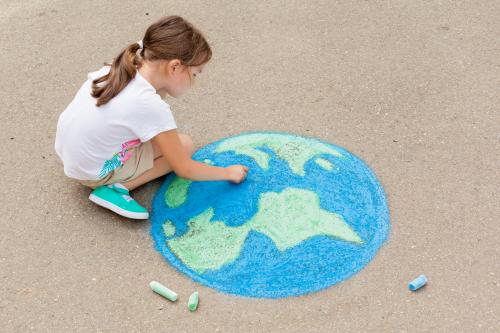This analysis marks the first blog in a series based on the report “A new green learning agenda: Approaches to quality education for climate action.”
Years of climate activism and advocacy at the policy level are on the cusp of bearing fruit in 2021. President-elect Biden will reinstate U.S. participation in the Paris Agreement and place environmental justice at the heart of U.S. climate policy and action. The U.K. presidency of COP26 will mobilize countries to raise their climate ambition, including a focus on climate and environmental literacy. And youth climate activists around the world will continue to bring new voices, including feminist climate leadership, and new entry points, like girls’ education and climate justice, into climate decisionmaking and solutions. With the optimism of a brand-new year upon us, it’s time now to roll up our sleeves and get to work.
As discussions about climate change and education begin to shift from policy advocacy to policy implementation, stakeholders and leaders, including those in the Biden transition team, will be looking for resources and frameworks to diagnose, strategize, and plan for the urgent reorientation of their education systems to carbon neutrality and climate literacy. While addressing the carbon footprint of education infrastructure is important (e.g., the energy efficiency of school buildings or food waste), the harder task at hand is to ensure that teaching and learning across all curricular areas of K-12, higher education, and career and technical education are oriented not just toward achieving climate literacy, but also toward climate action and climate justice.
Pressed with the urgency of runaway climate change and ecological collapse, the task of shifting from advocating for education for climate action to implementing education for climate action will require policymakers to identify pathways to the deeper ontological transformation of education.
This task goes beyond curricular reform aimed at adding climate change and environmental concepts into existing curriculum. While an important step, such reformative change allows the education sector to continue to avoid confronting its underlying problem of purpose—that is, the purpose of a 21st century education system designed for the coal-powered days of the Industrial Revolution. Pressed with the urgency of runaway climate change and ecological collapse, the task of shifting from advocating for education for climate action to implementing education for climate action will require policymakers to identify pathways to the deeper ontological transformation of education.
Anticipating this policy moment, the new Brookings report “A new green learning agenda: Approaches to quality education for climate action” provides decisionmakers with a heuristic to identify entry points to quality education for climate action based on the framing of the problem, the vision of the solution, or the most politically palatable education objective. More importantly, it also is meant to help illuminate what dimensions of the climate crisis or climate solutions decisionmakers’ chosen educational approach does not address and where they must work with local stakeholders to chart a direct course.
This destination—a new green learning agenda—aims to serve as an orienting compass toward a more radical vision of education. At its core, this new green learning agenda seeks to redress social inequities exacerbated by the climate crisis (and the COVID-19 pandemic) first by nurturing an understanding and awareness that the health of human society is intricately interlinked with the health of the planet. And second, it seeks to redress inequities by developing the breadth of green skills across an individual’s lifetime required to increase humanity’s collective resilience and adaptive capacity. Achieving these twin goals means simultaneously addressing gender and racial inequality and a learning crisis redefined as the inability of our education systems to teach children, youth, and adults how to live within planetary boundaries.
But just as there is no single solution to climate change, there is no single educational approach that will help achieve the degree of behavioral and mindset change needed to reverse course. Some approaches may promise to have a greater impact than others, but the political feasibility of their implementation is their greatest limiting factor. Nonetheless, all solutions must be pursued. Decisionmakers must understand that they should not stop at a single education reform, but enable multiple policy pathways, unlock the financing mechanisms, and unleash the networks of educators and civil society organizations to transform education as we know it. Looking toward our collective recovery from the tragedies and hardships of 2020 and the persisting injustices borne by those historically oppressed, 2021 must be the year we accept the challenge and responsibility of doing education differently.
This analysis begins a series of blogs to unpack the three approaches highlighted in the new report as a starting point to implementing a new green learning agenda that responds to youth advocates’ demands for education for climate action and climate justice. To realize these approaches, federal and global leadership, national and international coordinating agencies, and overseas development assistance and domestic funding mechanisms are necessary. Specific to the incoming Biden administration, these approaches could also help guide U.S. bilateral assistance in education, especially girls’ education and gender empowerment, as well as U.S. technical assistance to countries in need of support achieving their own climate strategies. As policy advocacy shifts toward implementation, it is critical that climate and education stakeholders be in lockstep with each other as they start a new year of work toward systems transformation and solving humanity’s most wicked problems.







Commentary
How can we implement education for climate action and climate justice?
January 11, 2021